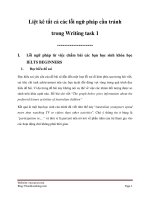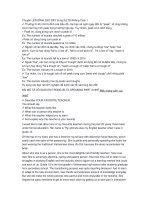IELTS writing samples task 1
Bạn đang xem bản rút gọn của tài liệu. Xem và tải ngay bản đầy đủ của tài liệu tại đây (29.52 KB, 5 trang )
1. DIAGRAM
The diagram shows the levels of charitable donations of people living in
Britain, separated by age, between 1990 and 2010.
Overall, there was a general decrease in the percentage of people who
donated money over the two time periods. However, the pattern differs
between the three age groups before 50 and the two age groups after the
age of 50.
The highest decrease was in the 18-25 category, which saw a decrease of
10%, from 17% in 1990 to 7% in 2010. 42% of people in the 36-50 age
group gave to charity in 1990, the highest on the chart, and this fell to 35%
in 2010. There was also a significant decline in donations among 26-35
year olds, from 31% to 24%.
The exception to this general trend downwards was among the 51-65 year
olds and over 65s. In 2010, the 51-65 year olds gave the highest percentage
with nearly 40 percent and this rose from 35% in 1990. Finally, those over
65 displayed a slight percentage increase of 3 percent.
(174 words)
2.
PIE CHARTS
The pie charts compare the amount of electricity created from five
different sources of fuel in France in 1990 and 2010. These were oil,
coal, natural gas, hydro power and nuclear power
Overall, the use of nuclear power for generating electricity in France
increased considerably, however, the use of natural gas declined
sharply over the two decades. In addition, oil and coal saw declines
and hydro power showed a slight decrease in consumption.
Nuclear power as a source of energy stood at 17% in 1990, however, it
showed a marked increase by 2010 making up 67% of electricity
production in France. In contrast, natural gas saw a big drop in supply
from 28% in 1990 to only 4% in 2010, a drop of 24% in a twenty year
period. Hydro power was the least popular form of energy in 1990 and
2010.
Similarly, oil and coal saw declines. Oil accounted for 22% of electricity
production in 1990, but by 2010 this accounted for 13%. Coal followed
this pattern and stood at 13% as a source of fuel for electricity, compared
to 28% in 1990. It is clear that nuclear power became the most relied on
form of energy for producing electricity in the two decades from 1990 to
2010.
3.
BAR CHART
The bar chart illustrates the gross domestic product generated from the IT
and Service Industry in the UK from 1992 to 2000. It is measured in
percentages.
Overall, it can be seen that both increased as a percentage of GDP, but IT
remained at a higher rate throughout this time.
At the beginning of the period, in 1992, the Service Industry accounted for
4 per cent of GDP, whereas IT exceeded this, at just over 6 per cent. Over the
next four years, the levels became more similar, with both components
standing between 6 and just over 8 per cent. IT was still higher overall,
though it dropped slightly from 1994 to 1996.
However, over the following four years, the patterns of the two components
were noticeably different. The percentage of GDP from IT increased quite
sharply to 12 in 1998 and then nearly 15 in 2000, while the Service
Industry stayed nearly the same, increasing to only 8 per cent. At the end of
the period, the percentage of GDP from IT was almost twice that of the
Service Industry.
(Words 182)
4. LINE GRAPH
The graph gives information about Burnaby Public Library between 2011
and 2014. It shows how many library books people read over this four-year
period.
As can be seen from the graph, there were different trends for men and
women. The number of books read by men increased steadily between
2011 and 2012, from about 3000 to 4000. After that, the number rose
dramatically to 14000 books in 2014. This was the highest figure in the
period.
Women started off reading more books than men, but their numbers
followed a different pattern. Between 2011 and 2012, there was an increase
of 3000 from 5000 books to 8000 books, and then a gradual rise to 10000
books in 2013. However, in 2014, their numbers fell back to 8000 again.
Overall, there was a strong upward trend in the number of books read by
men. Although women read more books than men in 2011, their reading
fell to below the level of men in 2014.
5. TABLE
The table illustrates the breakdown of scores for the IELTS General Test in
2010. It shows separate scores for all four modules (Listening, Reading,
Writing and Speaking), together with the overall band scores for students
from four different language groups around the world.
From an overall perspective, German speakers achieved the highest overall
band score. Moreover, they scored the highest of all four language groups in
three modules of the test (Listening, Writing, Speaking).
French speaking candidates scored the second highest overall score of 6.7
out of 9, closely followed by Malay and Indonesian speakers. Although
French speakers did not do so well in the Reading, Speaking and Listening
modules compared to Indonesian and Malay speakers, there was a
significant difference in their grades for the Writing module. These grades
were high relative to Indonesian and Malay candidates. Surprisingly, Malay
speakers, who achieved the second lowest result overall, achieved the
highest results of all four language groups for the Reading module.
As a final point, it is interesting to note that the scores for each module
show that all students, on average, scored the highest marks for the
Speaking module and the lowest marks for the Reading module.
(198 words)









